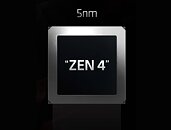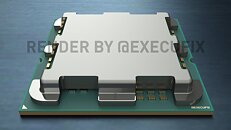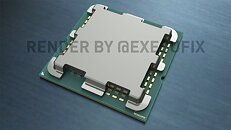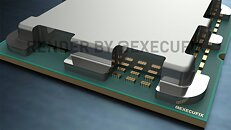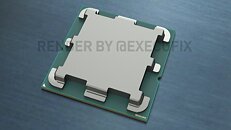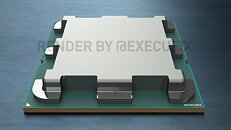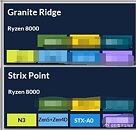May 5th, 2025 17:54 EDT
change timezone
Latest GPU Drivers
New Forum Posts
- What are you playing? (23553)
- Are the 8 GB cards worth it? (905)
- Graphics card..Need help. New to pc. 3070 (42)
- It's happening again, melting 12v high pwr connectors (1068)
- Post Your TIMESPY, PCMARK10 & FIRESTRIKE SCORES! (2019) (306)
- DTS DCH Driver for Realtek HDA [DTS:X APO4 + DTS Interactive] (2159)
- 9070XT Nitro vs Taichi? (13)
- What phone you use as your daily driver? And, a discussion of them. (1683)
- 12600KF high latency (29)
- Alienware AW2523HF 360Hz - Monitor with Poor Performance and Stuttering. (25)
Popular Reviews
- ASUS ROG Maximus Z890 Hero Review
- ASUS Radeon RX 9070 XT TUF OC Review
- Clair Obscur: Expedition 33 Performance Benchmark Review - 33 GPUs Tested
- Arctic Liquid Freezer III Pro 360 A-RGB Review
- Montech HS02 PRO Review
- Seasonic Vertex GX 850 W Review
- NVIDIA GeForce RTX 5060 Ti 8 GB Review - So Many Compromises
- Upcoming Hardware Launches 2025 (Updated Apr 2025)
- ASUS GeForce RTX 5090 Astral Liquid OC Review - The Most Expensive GPU I've Ever Tested
- Sapphire Radeon RX 9070 XT Nitro+ Review - Beating NVIDIA
Controversial News Posts
- AMD Radeon RX 9060 XT to Roll Out 8 GB GDDR6 Edition, Despite Rumors (131)
- NVIDIA Sends MSRP Numbers to Partners: GeForce RTX 5060 Ti 8 GB at $379, RTX 5060 Ti 16 GB at $429 (128)
- NVIDIA Launches GeForce RTX 5060 Series, Beginning with RTX 5060 Ti This Week (115)
- Nintendo Confirms That Switch 2 Joy-Cons Will Not Utilize Hall Effect Stick Technology (105)
- NVIDIA PhysX and Flow Made Fully Open-Source (95)
- Sony Increases the PS5 Pricing in EMEA and ANZ by Around 25 Percent (84)
- Parts of NVIDIA GeForce RTX 50 Series GPU PCB Reach Over 100°C: Report (78)
- Intel "Bartlett Lake-S" Gaming CPU is Possible, More Hints Appear for a 12 P-Core SKU (77)
News Posts matching #Raphael
Return to Keyword Browsing
Possible AMD Prototype Processor with DDR5 Memory Hits BAPCo CrossMark Database
Quite possibly the first sighting of a next-generation AMD processor with DDR5 memory surfaced on the web. A BAPCo CrossMark Database entry references a prototype processor with the name-string "AMD Eng Sample: 100-000000560-40_Y," running on a platform titled "ASUSTeK COMPUTER INC. M3402RA." The chip has 16 GB of memory across 2 memory channels, and a memory frequency of 4800 MHz DDR. The platform here could be either a desktop motherboard, or a notebook. 4800 MHz is an unusual memory speed for a mobile platform, unless it's a single stick of DDR5-4800 SO-DIMM, with two 40-bit channels.
The first notebooks with DDR5 memory make landfall early next year, when Intel launches mobile variants of its 12th Gen Core "Alder Lake" processors. This would mean that DDR5 SO-DIMMs are already in circulation with OEMs. If the theory of this being a mobile chip holds true, it could very well be the "Rembrandt" APU that combines "Zen 3+" CPU cores with an iGPU based on the RDNA2 graphics architecture. If however the platform is a prototype Socket AM5 motherboard, it could be one of the first sightings of a next-generation "Raphael" desktop processor with "Zen 4" CPU cores, and a combination of DDR5 memory and PCI-Express Gen 5.
The first notebooks with DDR5 memory make landfall early next year, when Intel launches mobile variants of its 12th Gen Core "Alder Lake" processors. This would mean that DDR5 SO-DIMMs are already in circulation with OEMs. If the theory of this being a mobile chip holds true, it could very well be the "Rembrandt" APU that combines "Zen 3+" CPU cores with an iGPU based on the RDNA2 graphics architecture. If however the platform is a prototype Socket AM5 motherboard, it could be one of the first sightings of a next-generation "Raphael" desktop processor with "Zen 4" CPU cores, and a combination of DDR5 memory and PCI-Express Gen 5.

AMD Ryzen Mobile "Raphael-H" Series Could Pack 16 Cores Based on Zen 4 Architecture
As we await the update of AMD's highly anticipated 6000 series Rembrandt APUs based on Zen 3 cores and RDNA2 graphics, we are in for a surprise with information about the next generation, more than a year away, of Ryzen 7000 series mobile processors based on Zen 4 architecture. Codenamed Raphael-H, it co-exists with the upcoming lineup of Phoenix APUs, which come after the 6000 series Rembrandt APU lineup. This mobile variant of the forthcoming desktop Raphael processors features as many as 16 cores based on Zen 4 architecture. What is so special about the Raphael-H is that it represents a mobile adaptation of desktop processors, and we are not sure how it will be different from the Phoenix APUs. However, we assume that Phoenix is going to feature a more powerful graphics solution.
The confusing thing is the timeline of these processors. First comes the Rembrandt APUs (6000 series) and then both the Raphael-H and Phoenix mobile processors. AMD could disable iGPU on mobile Raphael-H designs. However, that is just a guess. We have to wait to find out more in the upcoming months.
The confusing thing is the timeline of these processors. First comes the Rembrandt APUs (6000 series) and then both the Raphael-H and Phoenix mobile processors. AMD could disable iGPU on mobile Raphael-H designs. However, that is just a guess. We have to wait to find out more in the upcoming months.

AMD Zen 4 "Raphael" Processors Feature Improved Thermal Sensors and Power Management
AMD is slowly preparing the launch of the latest and greatest Ryzen processor family based on the Zen 4 CPU core design. Among various things that are getting an overhaul, the Raphael processor generation is now getting revamped temperature reading and better power management circuitry. According to an Igor's Lab report, AMD has prepared a few new improvements that will make temperature reading and power management easier for PC enthusiasts. Currently, the reported CPU temperature is called Tcontrol (Tctl), which is what the cooling solution sees. If Tctl is high, the fans spin up and cool the system. If Tctl is low, the fans slow down to reduce noise.
With Raphael, the CUR_TEMP (current temperature) output part of Tctl has been upgraded to reflect a much smoother curve, and avoid jittering with fans as they are not spiking so suddenly anymore. This is helping contribute to the noise output and has made it run at a consistent fan speed in the system. Another note about Raphael is a new power management technique. AMD has designed the AM5 platform to avoid sudden power spikes, to maintain maximum efficiency over time. It is a design decision made from the very start, and the CPU will try to constrain itself in the TDP range that it is configured for. For more details about the circuitry, please head over to the Igor's Lab article.
With Raphael, the CUR_TEMP (current temperature) output part of Tctl has been upgraded to reflect a much smoother curve, and avoid jittering with fans as they are not spiking so suddenly anymore. This is helping contribute to the noise output and has made it run at a consistent fan speed in the system. Another note about Raphael is a new power management technique. AMD has designed the AM5 platform to avoid sudden power spikes, to maintain maximum efficiency over time. It is a design decision made from the very start, and the CPU will try to constrain itself in the TDP range that it is configured for. For more details about the circuitry, please head over to the Igor's Lab article.

Alleged AMD AM5 Socket for Zen 4 Raphael Processors Leaks
AMD is slowly preparing to launch its next-generation processors based on the new AM5 socket. The new lineup of processors will be based on the upgraded Zen 4 architecture that is said to bring multiple microarchitecture improvements and enhancements, equaling to a possible high-performance increase. Today, according to ExecutableFix, the person who provided us with renders of AMD's upcoming AM5 socket designed for next-generation Raphael processors. As we previously reported, AM5 is doing away from PGA and switching to LGA type instead, where pins are delivered on the socket, not the CPU like we used to see with AMD processors.
The LGA-1718 socket, pictured in the renders below, looks like a simple retention mechanism, where there is one metal arm to hold the lid down under pressure. If it turns out to be true, this implementation will be a very positive upgrade over the past PGA socket found on AM4 and before. We can look forward to seeing what AMD will deliver once the launch of Raphael processors gets closer.
The LGA-1718 socket, pictured in the renders below, looks like a simple retention mechanism, where there is one metal arm to hold the lid down under pressure. If it turns out to be true, this implementation will be a very positive upgrade over the past PGA socket found on AM4 and before. We can look forward to seeing what AMD will deliver once the launch of Raphael processors gets closer.

AMD Zen 4 Desktop Processors Likely Limited to 16 Cores, 170 W TDP
We have recently seen several reputable rumors confirming that AMD's Zen 4 Raphael desktop processors will be limited to 16 cores with 2 compute units. There were previous rumors of a 24 core model with 3 compute units however that now seems unlikely. While the core counts won't increase some skews may see a TDP increase up to 170 W which should offer some performance uplift. AMD is expected to debut their 5 nm Zen 4 Raphael desktop processors in 2022 which will come with support for PCIe 5.0 and DDR5. The processors will switch to a new AM5 LGA1718 socket and will compete with Intel's Alder Lake-S successor Raptor Lake which could feature 24 cores.

AMD Raphael CPU IHS Features Cutouts for Capacitors
Last week,we have covered the leak of AMD's upcoming Raphael processor integrated heat spreader (IHS), which featured a rather unique design. While we have made speculations as to why the design was made like that, it seems that we now have an answer to the question. It was previously believed that the unique IHS design was there to protect a double-substrate design, like Intel designed with Skylake-X. However, thanks to the updated design by ExecutableFix, we now know that AMD's design choice for Raphael is based on the simple fact that the IHS needs those cutouts for capacitors, as this seems to be the only place to have them.
As you can see below, there was no room on the LGA side, where the LGA pads are placed, and a lot of speculation suggested that capacitors were placed under the IHS or in IHS cutouts. The latter has proven to be the case according to this leak. You can check out some of the updated renderings in the images below.
As you can see below, there was no room on the LGA side, where the LGA pads are placed, and a lot of speculation suggested that capacitors were placed under the IHS or in IHS cutouts. The latter has proven to be the case according to this leak. You can check out some of the updated renderings in the images below.

AMD Ryzen 7000 Series "Raphael" Zen 4 Processor IHS Design Gets Leaked
AMD is preparing to switch things up a bit with its upcoming AM5 platform. The new platform is said to bring significant changes to the design of the socket and the CPU package, where we will see some new design choices and decisions. For starters, all of the processors made for the AM5 platform will come in a land grid array (LGA) configuration, very similar to that of Intel. Thanks to the rendering of ExecutableFix, we got to see exactly how will the new LGA design look like. And today, we get to see more details of the AMD's upcoming Raphael processor's integrated heat spreader (IHS) design.
The IHS serves the purpose of spreading the heat away from the die and dissipating it efficiently. However, IHS designs can sometimes be very interesting. According to this rendering from ExecutableFix, AMD's upcoming Raphael design, based on Zen 4 core, will feature a unique IHS design, which can be seen below.
The IHS serves the purpose of spreading the heat away from the die and dissipating it efficiently. However, IHS designs can sometimes be very interesting. According to this rendering from ExecutableFix, AMD's upcoming Raphael design, based on Zen 4 core, will feature a unique IHS design, which can be seen below.

AMD Ryzen 8000 Series Processors Based on Zen 5 Architecture Reportedly Codenamed "Granite Ridge"
Today, we have talked about AMD's upcoming Raphael lineup of processors in the article you can find here. However, it seems like the number of leaks on AMD's plans just keeps getting greater. Thanks to the "itacg" on Weibo, we have learned that AMD's Ryzen 8000 desktop series of processors are reportedly codenamed as Granite Ridge. This new codename denotes the Zen 5 based processors, manufactured on TSMC's 3 nm (N3) node. Another piece of information is that AMD's Ryzen 8000 series APUs are allegedly called Strix Point, and they also use the 3 nm technology, along with a combination of Zen 5 and Zen 4 core design IPs. We are not sure how this exactly works out, so we have to wait to find out more.

Rumor: AMD Ryzen 7000 (Raphael) to Introduce Integrated GPU in Full Processor Lineup
The rumor mill keeps crushing away; in this case, regarding AMD's plans for their next-generation Zen designs. Various users have shared pieces of the same AMD roadmap, which apparently places AMD in an APU-focused landscape come their Ryzen 7000 series. we are currently on AMD's Ryzen 5000-series; Ryzen 6000 is supposed to materialize via a Zen 3+ design, with improved performance per watt obtained from improvements to its current Zen 3 family. However, Ryzen 7000-series is expected to debut on AMD's next-gen platform (let's call it AM5), which is also expected to introduce DDR5 support for AMD's mainstream computing platform. And now, the leaked, alleged roadmaps paint a Zen 4 + Navi 2 APU series in the works for AMD's Zen 4 debut with Raphael - roadmapped for manufacturing at the 5 nm process.
The inclusion of an iGPU chip with AMD's mainstream processors may signal a move by AMD to produce chiplets for all of its products, and then integrating them in the final product. You just have to think about it in the sense that AMD could "easily" pair one of the eight-core chiplets from the current Ryzen 5800X, for example, with an I/O die (which would likely still be fabricated with Global Foundries) an an additional Navi 2 GPU chiplet. It makes sense for AMD to start fabricating GPUs as chiplets as well - AMD's research on MCM (Multi-Chip Module) GPUs is pretty well-known at this point, and is a given for future development. It means that AMD needed only to develop one CPU chiplet and one GPU chiplet which they can then scale on-package by adding in more of the svelte pieces of silicon - something that Intel still doesn't do, and which results in the company's monolithic dies.
The inclusion of an iGPU chip with AMD's mainstream processors may signal a move by AMD to produce chiplets for all of its products, and then integrating them in the final product. You just have to think about it in the sense that AMD could "easily" pair one of the eight-core chiplets from the current Ryzen 5800X, for example, with an I/O die (which would likely still be fabricated with Global Foundries) an an additional Navi 2 GPU chiplet. It makes sense for AMD to start fabricating GPUs as chiplets as well - AMD's research on MCM (Multi-Chip Module) GPUs is pretty well-known at this point, and is a given for future development. It means that AMD needed only to develop one CPU chiplet and one GPU chiplet which they can then scale on-package by adding in more of the svelte pieces of silicon - something that Intel still doesn't do, and which results in the company's monolithic dies.
May 5th, 2025 17:54 EDT
change timezone
Latest GPU Drivers
New Forum Posts
- What are you playing? (23553)
- Are the 8 GB cards worth it? (905)
- Graphics card..Need help. New to pc. 3070 (42)
- It's happening again, melting 12v high pwr connectors (1068)
- Post Your TIMESPY, PCMARK10 & FIRESTRIKE SCORES! (2019) (306)
- DTS DCH Driver for Realtek HDA [DTS:X APO4 + DTS Interactive] (2159)
- 9070XT Nitro vs Taichi? (13)
- What phone you use as your daily driver? And, a discussion of them. (1683)
- 12600KF high latency (29)
- Alienware AW2523HF 360Hz - Monitor with Poor Performance and Stuttering. (25)
Popular Reviews
- ASUS ROG Maximus Z890 Hero Review
- ASUS Radeon RX 9070 XT TUF OC Review
- Clair Obscur: Expedition 33 Performance Benchmark Review - 33 GPUs Tested
- Arctic Liquid Freezer III Pro 360 A-RGB Review
- Montech HS02 PRO Review
- Seasonic Vertex GX 850 W Review
- NVIDIA GeForce RTX 5060 Ti 8 GB Review - So Many Compromises
- Upcoming Hardware Launches 2025 (Updated Apr 2025)
- ASUS GeForce RTX 5090 Astral Liquid OC Review - The Most Expensive GPU I've Ever Tested
- Sapphire Radeon RX 9070 XT Nitro+ Review - Beating NVIDIA
Controversial News Posts
- AMD Radeon RX 9060 XT to Roll Out 8 GB GDDR6 Edition, Despite Rumors (131)
- NVIDIA Sends MSRP Numbers to Partners: GeForce RTX 5060 Ti 8 GB at $379, RTX 5060 Ti 16 GB at $429 (128)
- NVIDIA Launches GeForce RTX 5060 Series, Beginning with RTX 5060 Ti This Week (115)
- Nintendo Confirms That Switch 2 Joy-Cons Will Not Utilize Hall Effect Stick Technology (105)
- NVIDIA PhysX and Flow Made Fully Open-Source (95)
- Sony Increases the PS5 Pricing in EMEA and ANZ by Around 25 Percent (84)
- Parts of NVIDIA GeForce RTX 50 Series GPU PCB Reach Over 100°C: Report (78)
- Intel "Bartlett Lake-S" Gaming CPU is Possible, More Hints Appear for a 12 P-Core SKU (77)

